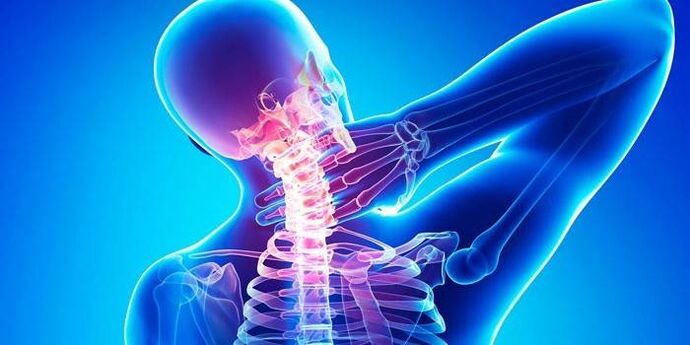Another name for this disease is a deductive degenerative deductive lesion of the spine, it affects the body of the vertebrae, ligament and joint devices, intervertebral discs.It is equally diagnosed in men and women, as a rule, it develops after 30 years.According to statistics, from 50 to 80% of the population suffers from this disease.

Classification of symptoms for cervical osteochondosis
The development of this disorder sometimes occurs before 30-35 years, therefore the signs of the disease can also occur in adolescence.The signs of cervical osteochondosis are discussed in detail below, the disease has become a real problem of the modern world.Sedentary work, a long stay in front of the computer negatively affects the state of health, the well -being of a person.All symptoms of cervical osteochondosis are associated with malfunctions in the functioning of different systems:
- In advanced cases, there are signs of pressing, the integrity of the spinal cord in the spinal canal is violated.
- The pathological process is able to influence the peripheral nervous system.The roots of the spinal nucleus located next to the outbreaks of the deformation of bone skin tissue are exposed to negative effects.
- In some cases, vertebral arteries are pinched.These blood vessels provide nutrients, oxygen to brain cells.The violation of these processes leads to a strong deterioration of human well -being.
Pain

It is known that one of the first signs of the development of the disease is pain in the cervical region.Initially it passes quickly, it is periodic, but then it enters a chronic form.The main places of pain location are:
- the occipital muscles (improved when the neck, inclinable of the head);
- shoulder area;
- neck.
It can damage differently depending on the position of the injury, unpleasant sensations can be acute, shootings, periodically decreased, becing and constant.Over time, the movements of the head are difficult, which is associated with the tension of the neck muscles.If the artery is pinched, sometimes the cervical migraine is observed (with the weakening of the blood supply, the lack of oxygen appears a headache).
Nausea
In some cases, the blood vessels of the circulatory system are squeezed, which guarantees the flow of oxygen, nutrients to the human brain, the internal ear.For this reason, nausea occurs in osteocondrosis.These symptoms are normally accompanied by loss of appetite, which causes weight loss, deficiency of the necessary nutrients.In the following stages, the disease can cause vomiting when turning the head, walk or inclination.This is due to the lack of blood flow to the middle ear, where the balance center is located.
Neurological symptoms of cervical osteochondosis

Some manifestations of the disease cannot be immediately attributed to characteristics characteristics.You should know which symptoms with cervical osteochondrosis cannot be ignored, for example a lack of air.With the damage to this department, the diaphragmatic nerve irritation syndrome can develop.The patient has difficulty breathing, there is a lack of oxygen, which causes lack of breath and even serious suffocation.
This manifestation of pathology is often accompanied to be snoring, has improved if we take an uncomfortable position during sleep.This leads to the fact that a person will not rest at night, wakes up with a sense of general malaise, weakness, feels tired and broken.In the absence of treatment, this condition can lead to a deterioration of memory, a decrease in concentration and irreversible changes in the brain tissue.
Vestibular signs
Another direction, how osteochondosis of the cervical region is manifested: vestibular signs.The supply of the brain with all the necessary nutrients occurs through the vertebral arteries.If the cervical osteochondosis develops, in which the work of the internal ear is disturbed, the patient experiences noise in the ears and rings.In some cases, a violation or decrease in hearing is added to these symptoms.
Lump in the throat
In some cases, the disease manifests itself only by a symptom: it is difficult to swallow.It seems that a lump has formed in the throat with osteochondrosis of the cervical column, there is a dozen, itching, dryness and swallowing is difficult.These events are associated with a violation of the conduct of neurovascular trunks that emanates from the spinal cord.A lump in the throat is not a specific symptom of osteochondrosis, it can indicate a tumor or an inflammatory process.When this sign appears, you should absolutely consult a doctor.
The visual signs of osteochondosis of the cervical region
The symptoms of the osteochdrosis of the cervical column can be different, but the visual impairment of altered visual visual compromise.The supply of visual analyzers occurs through carotids and vertebrates.If a decrease in blood circulation occurs due to the compression of the latter, a decrease in vision begins, which does not improve when wearing points.Cervical osteochondrosis - Symptoms:

- reduced pressure;
- "Floating", trembling points;
- atherosclerosis of the arteries in the brain;
- violation of the concentration on the subject;
- Veil, fog in front of my eyes.
A characteristic feature that a decrease in vision is due to Pizzichi by the vertebral pot, circulatory disorders, it will be the lack of improvements when wearing glasses, performing special exercises.Only the timely treatment of the underlying disease (before the injuries of irreversible tissues) will help change the condition.
Arterial signs
The spine plays an important role in the human body, therefore any disease affects many systems.There are some arterial signs of cervical osteochondrosis, which indicate this disease.These include a sudden loss of consciousness.This is the most unpleasant and dangerous symptom that is inherent in this disease.This happens due to circulatory disorders, when the blood temporarily ceases to flow through the brain arteries.
A pronounced spasm of arteries occurs due to the response of bone processes deformed to the irritation of nerve endings.If your knowledge has osteochondosis of the cervical region and has lost consciousness, it must be laid, lift the legs on a small hill to increase the flow of blood from the limbs and increase the intake to the brain.After that, the people, as a rule, go quickly in their senses.
The instability of blood pressure is another symptom of the disease of this group.Doctors can diagnose abrupt indicators if the blood flow is disturbed.This is not a specific symptom of osteocondrosis, but adapts to the general picture of the disease.Blood pressure can decrease or increase.A person feels a deterioration of the condition, therefore he needs to guarantee peace.
Dizziness
Previously it had been described that with this disease, sometimes there is a loss of consciousness.This applies to cases where blood flow to the brain was very difficult.More often, patients experience dizziness for cervical osteochondrosis.This is a frequent symptom that accompanies all patients with this disease.This phenomenon has a spontaneous nature of the event.The cause of this condition is a reduction in the quantity of oxygen coming to the internal ear.It is located in the human brain, it is responsible for a sense of balance.The dizziness occur to:
- turn the head, neck;
- If you get out of bed abruptly.
The temperature for osteochondosis

In some cases, pathological processes spread among the structures of the cervical segment of the spinal cord.This happens when the disc is increased, the canal stenosis.The temperature for osteochondrosis is the body response to pathology data.The same reaction is possible with the vertebral artery syndrome.This is a frequent phenomenon for osteochondrosis in the last stages of the development of the disease.Therefore, an increase in temperature refers to non -specific symptoms of the disease.
This sign will not be present, the thermoregulation of the body could be normal.If you feel constant pains in the neck, in the shoulders, in the neck and when you turn or incline your head, the exacerbation occurs, it is necessary to contact a specialist, undergo an exam.The lack of treatment will necessarily lead to the fact that the condition will determine, the level of comfort of life will decrease.
























